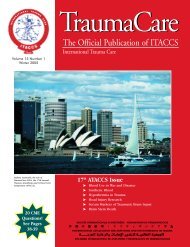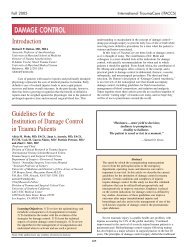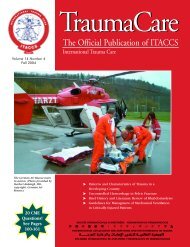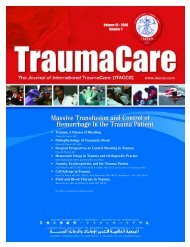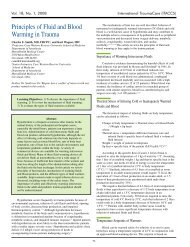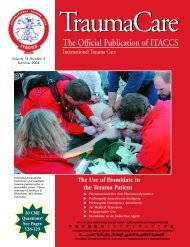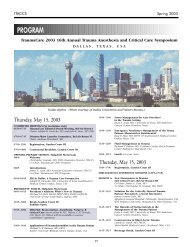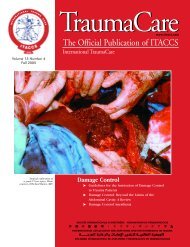The Official Publication of ITACCS - International Trauma ...
The Official Publication of ITACCS - International Trauma ...
The Official Publication of ITACCS - International Trauma ...
You also want an ePaper? Increase the reach of your titles
YUMPU automatically turns print PDFs into web optimized ePapers that Google loves.
<strong>ITACCS</strong> Spring 2003<br />
tions such as airway assessment; oxygenation and ventilation; aspiration prophylaxis; cervical<br />
spine protection; and confirmation <strong>of</strong> tracheal intubation. However, it differs from other algorithms<br />
in the presentation <strong>of</strong> the six limbs, i.e., 1) first responder limb for providers who generally<br />
do not possess tracheal intubation skills and may or may not have rescue ventilation<br />
skills; 2) nonintubation technique limb, which allows the provider to opt out <strong>of</strong> using tracheal<br />
intubation if the situation dictates and to either continue with a nonrebreathing mask or bagvalve<br />
mask ventilation or proceed with a minimally invasive technique such as Combitube,<br />
COPA, Easy Tube, King LT or LMA; 3) rescue ventilation limb, which provides for rapid insertion<br />
<strong>of</strong> a Combitube or LMA or LMA-Fastrach in the presence <strong>of</strong> a crash airway or failed airway<br />
situation; 4) difficult intubation limb, which provides options for facilitating a difficult<br />
intubation; 5) RSI limb, which focuses on appropriate use <strong>of</strong> rapid sequence intubation; and<br />
6) cricothyrotomy limb for application if rescue ventilation fails.<br />
<strong>The</strong> flowchart assists in improving oxygenation and ventilation regardless <strong>of</strong> the<br />
provider’s skill level. Other contributions include use <strong>of</strong> limiting intubation attempts to avoid<br />
traumatizing the airway or creating a “cannot ventilate–cannot intubate”; 6 “Mason’s PU-92<br />
Concept” for rapid recognition <strong>of</strong> the crash airway 1 ; maxims and special considerations to<br />
facilitate airway safety; technique adjustment if adequate oxygenation is not being attained or<br />
maintained; clear criteria for application <strong>of</strong> rescue ventilation to treat a failed or crash airway;<br />
criteria for application <strong>of</strong> cricothyrotomy; and near-failsafe devices in all locations to confirm<br />
tracheal intubation. Use <strong>of</strong> color to show safe blocks, danger blocks, decision blocks, consideration<br />
blocks, and action blocks aids in instruction and acquisition <strong>of</strong> information.<br />
Conclusions. A flowchart has been developed that can be used by all practitioners<br />
involved in emergency airway management. It provides a platform for teaching critical decisionmaking<br />
skills to diverse practitioners. It is hoped that a tool can be developed to measure its<br />
effect on providers’ ability to apply critical decision-making skills effectively in emergency airway<br />
management. <strong>The</strong> flowchart is germane to that common area <strong>of</strong> emergency airway management<br />
where the diverse fields <strong>of</strong> anesthesiology, emergency medicine, and prehospital care coincide.<br />
References<br />
1. Mason AM. <strong>The</strong> Laryngeal Mask Airway (LMA) & Intubating Laryngeal Mask Airway<br />
(ILMA) in Prehospital <strong>Trauma</strong> Care. Presentation at the Royal College <strong>of</strong><br />
Anaesthetists, London, May 13, 2002.<br />
2. ASA Task Force on Management <strong>of</strong> the Difficult Airway. Anesthesiology 1993; 78:597.<br />
3. Gabbott DA. Management <strong>of</strong> the airway and ventilation during resuscitation. Br J<br />
Anaesth 1997; 79:159–71.<br />
4. Walls RW. <strong>The</strong> emergency airway algorithms. In Walls RW, ed. Manual <strong>of</strong> Emergency<br />
Airway Management. Philadelphia: Lippincott Williams & Wilkins, 2000, pp 16–26.<br />
5. Smith CE, Grande CM, Wayne MA, et al. <strong>ITACCS</strong> Rapid Sequence Intubation (RSI)<br />
in <strong>Trauma</strong> [poster]. 10th ATACCS. Baltimore, May 1997.<br />
6. Benum<strong>of</strong> JL. <strong>The</strong> ASA Difficult Airway Algorithm: new thoughts and considerations.<br />
In Hagberg CA, ed. Handbook <strong>of</strong> Difficult Airway Management. Philadelphia:<br />
Churchill Livingstone, 2000, pp 31–48.<br />
Friday, May 16, 2003<br />
Simultaneous Morning Sessions<br />
— Session A —<br />
<strong>Trauma</strong> Airway Management<br />
Chair: Andreas Thierbach, MD, Mainz, Germany<br />
RECOGNIZED<br />
PROPER<br />
PREPARATION<br />
AWAKE<br />
INTUBATION<br />
CHOICES* +<br />
SUCCEED<br />
SURGICAL<br />
AIRWAY<br />
CANCEL CASE,<br />
REGROUP (e.g.,<br />
different personnel/<br />
equipment)<br />
DIFFICULT AIRWAY<br />
UNCOOPERATIVE<br />
PATIENT<br />
UNRECOGNIZED<br />
MASK VENT<br />
NONPROLEMATIC<br />
FAIL<br />
REGIONAL<br />
ANESTHESIA<br />
(if possible and<br />
surgery reversible)<br />
GENERAL<br />
ANESTHESIA<br />
+ PARALYSIS ++<br />
MASK<br />
VENTILATION<br />
AWAKEN<br />
YES<br />
(non emergency<br />
pathway)<br />
INTUBATION<br />
CHOICES * +<br />
FAIL<br />
+<br />
NO<br />
(emergency<br />
pathway)<br />
SUCCEED<br />
SURGICAL<br />
AIRWAY<br />
++<br />
+<br />
Always consider calling for help (e.g., technical,<br />
medical, surgical etc.) when difficulty with mask<br />
ventilation and/or tracheal intubation is encountered<br />
Consider the need to preserve spontaneous<br />
ventilation<br />
LMA,<br />
COMBITUBE,<br />
TTJV<br />
AWAKEN<br />
INTUBATION<br />
CHOICES* +<br />
SURGICAL<br />
AIRWAY<br />
CONFIRM<br />
when<br />
EXTUBATE<br />
OVER JET<br />
appropriate<br />
STYLET<br />
ANESTHESIA WITH<br />
MASK VENTILATION<br />
Figure 1. <strong>The</strong> ASA Difficult Airway Algorithm from References 1 and 2.<br />
*Non-surgical tracheal intubation choices consist <strong>of</strong> laryngoscopy with a rigid laryngoscope blade (many types), blind<br />
orotracheal or nasotracheal technique, fiberoptic/stylet technique, retrograde technique, illuminating stylet, rigid<br />
bronchoscope, percutaneous dilational tracheal entry. See Reference 2 for a complete discussion <strong>of</strong> these TI choices.<br />
<strong>The</strong> ASA Difficult Airway Algorithm As It Pertains to <strong>Trauma</strong> Patients<br />
William C. Wilson, MD<br />
University <strong>of</strong> California, San Diego School <strong>of</strong> Medicine, San Diego, California, USA<br />
Learning Objectives: 1) to review the ASA difficult airway (DA) algorithm, 2) to recognize<br />
that most <strong>of</strong> the important elements <strong>of</strong> the algorithm apply equally well to the elective<br />
setting and the emergency trauma setting, and 3) to identify special considerations<br />
and solutions related to trauma airway situations.<br />
Pre-induction Airway Evaluation. <strong>The</strong> ASA DA Algorithm (Figure 1) begins with<br />
recognition <strong>of</strong> airway difficulty. Whenever the patient is recognized to have a difficult airway<br />
(and the patient is stable and cooperative), the clinician should secure the airway awake.<br />
Awake Limb <strong>of</strong> the ASA Algorithm. <strong>The</strong> ASA DA algorithm does not endorse any<br />
particular airway technique. However, it does emphasize that the patient must be properly<br />
prepared (both mentally and physically) for an awake technique, and the physician must<br />
ensure continuation <strong>of</strong> spontaneous ventilation and adequacy <strong>of</strong> O 2 saturation.<br />
Stopping to Come Back Another Day (Seldom an Option with <strong>Trauma</strong>). If<br />
awake intubation techniques fail, one can, and should, consider stopping, maintaining spontaneous<br />
ventilation, allowing the patient to recover from topicalization or sedatives and<br />
resume management later with a better plan (other equipment/personnel). However, stopping<br />
is seldom an option when managing the emergency trauma airway.<br />
Anesthetized or Uncooperative Patient Limb <strong>of</strong> ASA Algorithm. <strong>The</strong>re are three<br />
common conditions when the need arises to intubate the trachea <strong>of</strong> an unconscious or anesthetized<br />
patient with a DA: 1) <strong>The</strong> clinician fails to recognize a difficult airway in preoperative<br />
evaluation prior to the induction <strong>of</strong> anesthesia. 2) <strong>The</strong> DA patient who is already unconscious<br />
prior to being assessed by the trauma anesthesiologist. 3) <strong>The</strong> patient has an obvious DA but<br />
is hemodynamically unstable (i.e., following trauma) or absolutely refuses to cooperate with<br />
an awake intubation (child, or mentally retarded, or drugged or head-injured adult). Once<br />
the patient is anesthetized or is rendered apneic or presents comatose and the trachea cannot<br />
be intubated, O 2 -enriched mask ventilation is attempted. If adequate, a number <strong>of</strong> intubation<br />
techniques may be employed. Techniques allowing continuous ventilation during airway<br />
manipulations are favored over those requiring an interruption <strong>of</strong> mask ventilation (e.g.,<br />
fiberoptic bronchoscope, via an LMA or an airway intubating mask, with self-sealing<br />
diaphragm). Alternatively, techniques requiring a cessation <strong>of</strong> ventilation (at least temporarily)<br />
can be employed (these techniques are relatively contraindicated for patients with large<br />
right-to-left transpulmonary shunt or decreased FRC).<br />
Three Emergency Airway Aides (LMA , Combitube, and TTJV) Assist the<br />
Cannot Intubate/Cannot Ventilate Patient. When confronted with this type <strong>of</strong> patient,<br />
three alternative ventilation methods should be considered (Combitube, LMA, TTJV). Once<br />
ventilation is established with one <strong>of</strong> these methods, other more definitive (and time-consuming)<br />
techniques <strong>of</strong> airway management may be considered.<br />
Confirmation <strong>of</strong> Endotracheal Tube Position. Immediately after the patient’s trachea<br />
is intubated, one must confirm endotracheal tube position with end tidal CO 2 measurement.<br />
If end tidal CO 2 measurement is unavailable, the Wee’s esophageal detector device<br />
is reasonably reliable (close to 100% sensitive and specific).<br />
Extubation or Endotracheal Tube Change <strong>of</strong> the Difficult Airway. If the conditions<br />
that caused the airway to be difficult to intubate still exist at the time <strong>of</strong> extubation, or<br />
if new DA conditions exist (e.g., airway edema, Halo), then the trachea should be extubated<br />
over an airway exchange catheter and/or with the assistance <strong>of</strong> a fiberoptic bronchoscope.<br />
References<br />
1. Benum<strong>of</strong> JL. Laryngeal mask airway and the ASA difficult airway algorithm..<br />
Anesthesiology 1996; 84:686-99.<br />
2. Wilson WC, Benum<strong>of</strong> JL. Pathophysiology evaluation and treatment <strong>of</strong> the difficult<br />
airway. Anesthesiol Clin North Am 1998; 16(1):29-75.<br />
Controversies and Obstacles to Airway Training for Paramedics<br />
Adolph H. Giesecke, MD<br />
Retired Jenkins Pr<strong>of</strong>essor and Former Chairman, Anesthesiology and Pain Management<br />
Univeristy <strong>of</strong> Texas Southwestern Medical School, Dallas, Texas, USA<br />
Medical doctors, paramedics, and educators all agree that paramedics should be taught<br />
management <strong>of</strong> the airway. Curriculum should include evaluation <strong>of</strong> the airway and breathing,<br />
airway-clearing maneuvers, bag and mask ventilation, oral and nasal airway insertion, and<br />
endotracheal intubation. Teaching methods should include lectures, teaching movies,<br />
manikin practice, and experience in an operating room supervised by an anesthesiologist or<br />
nurse anesthetist. Most programs require a minimum <strong>of</strong> five supervised intubations before<br />
the course is complete. <strong>The</strong> supervised OR experience improves the successful attempts in<br />
the field from 50% to 95%.<br />
<strong>The</strong> supervised OR experience carries proven benefits to the paramedic and to the<br />
patients, but it is becoming less and less available over the nation. One by one hospitals, anesthesiologists,<br />
and nurse anesthetists have withdrawn from <strong>of</strong>fering this valuable training to<br />
paramedics. <strong>The</strong> reasons <strong>of</strong>fered include fear <strong>of</strong> liability, advice <strong>of</strong> liability insurance carriers,<br />
problems with informed consent and increasing use <strong>of</strong> the LMA in routine surgery.<br />
I don’t have magic bullets to propose to solve the problem, except to strongly repeat the<br />
time honored argument, “When you have your cardiac arrest, what level <strong>of</strong> success will you<br />
accept from your paramedic: 50% or 95%?” Anesthesiologists and nurse anesthetists must continue<br />
to <strong>of</strong>fer this training. Insurance companies must accept the minimal risk associated with<br />
this training, and we must all work on the problem <strong>of</strong> informed consent. We must also carefully<br />
evaluate the use <strong>of</strong> the LMA and Combitube as rescue airways in emergency medical services.<br />
Airway Management with Penetrating Neck <strong>Trauma</strong><br />
Vance E. Shearer, MD<br />
Associate Pr<strong>of</strong>essor, Department <strong>of</strong> Anesthesiology and Pain Management; University <strong>of</strong><br />
Texas Southwestern Medical Center at Dallas; Dallas, Texas, USA<br />
Learning Objectives: 1) To understand the need for an individualized approach<br />
to patients with penetrating neck injuries, 2) to appreciate the indications for and utility <strong>of</strong><br />
fiberoptic bronchoscopy and retrograde intubation in the management <strong>of</strong> penetrating<br />
neck trauma, 3) to understand the need for topical anesthesia during bronchoscopy, 4) to<br />
realize the dangers associated with blind intubation and direct laryngoscopy during the<br />
management <strong>of</strong> penetrating neck trauma, and 5) to recognize the situations in which creation<br />
<strong>of</strong> a surgical airway is warranted.<br />
<strong>The</strong> airway can be distorted significantly by a penetrating neck injury. Standard management<br />
algorithms do not adequately cover the establishment <strong>of</strong> a secure airway in patients<br />
with this type <strong>of</strong> injury. Until prospective studies are completed, the best technique for intubation<br />
remains controversial; meanwhile, each patient’s airway must be approached on an<br />
individual basis.<br />
47




